Concentration-Dependent Diversifcation Effects of Free Cholesterol Loading on Macrophage Viability and Polarization
- PMID: 26314949
- PMCID: PMC4752209
- DOI: 10.1159/000430365
Concentration-Dependent Diversifcation Effects of Free Cholesterol Loading on Macrophage Viability and Polarization
Abstract
Background/aims: The accumulation of free cholesterol in atherosclerotic lesions has been well documented in both animals and humans. In studying the relevance of free cholesterol buildup in atherosclerosis, contradictory results have been generated, indicating that free cholesterol produces both pro- and anti-atherosclerosis effects in macrophages. This inconsistency might stem from the examination of only select concentrations of free cholesterol. In the present study, we sought to investigate the implication of excess free cholesterol loading in the pathophysiology of atherosclerosis across a broad concentration range from (in µg/ml) 0 to 60.
Methods: Macrophage viability was determined by measuring formazan formation and flow cytometry viable cell counting. The polarization of M1 and M2 macrophages was differentiated by FACS (Fluorescence-Activated Cell Sorting) assay. The secretion of IL-1β in macrophage culture medium was measured by ELISA kit. Macrophage apoptosis was detected by flow cytometry using a TUNEL kit.
Results: Macrophage viability was increased at the treatment of lower concentrations of free cholesterol from (in µg/ml) 0 to 20, but gradually decreased at higher concentrations from 20 to 60. Lower free cholesterol loading induced anti-inflammatory M2 macrophage polarization. The activation of the PPARx03B3; (Peroxisome Proliferator-Activated Receptor gamma) nuclear factor underscored the stimulation of this M2 phenotype. Nevertheless, higher levels of free cholesterol resulted in pro-inflammatory M1 activation. Moreover, with the application of higher free cholesterol concentrations, macrophage apoptosis and secretion of the inflammatory cytokine IL-1β increased significantly.
Conclusion: These results for the first time demonstrate that free cholesterol could render concentration-dependent diversification effects on macrophage viability, polarization, apoptosis and inflammatory cytokine secretions, thereby reconciling the pros and cons of free cholesterol buildup in macrophages to the pathophysiology of atherosclerosis.
© 2015 S. Karger AG, Basel.
Figures


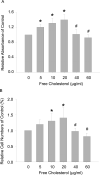


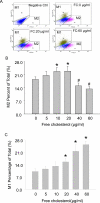
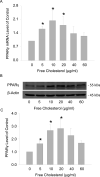

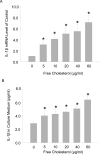
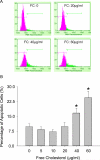
Similar articles
-
Docosahexaenoic acid induces M2 macrophage polarization through peroxisome proliferator-activated receptor γ activation.Life Sci. 2015 Jan 1;120:39-47. doi: 10.1016/j.lfs.2014.10.014. Epub 2014 Oct 31. Life Sci. 2015. PMID: 25445227
-
Conversion of human M-CSF macrophages into foam cells reduces their proinflammatory responses to classical M1-polarizing activation.Atherosclerosis. 2016 May;248:170-8. doi: 10.1016/j.atherosclerosis.2016.03.012. Epub 2016 Mar 10. Atherosclerosis. 2016. PMID: 27038418
-
Cytokine response to lipoprotein lipid loading in human monocyte-derived macrophages.Lipids Health Dis. 2006 Jun 26;5:17. doi: 10.1186/1476-511X-5-17. Lipids Health Dis. 2006. PMID: 16800873 Free PMC article.
-
Atorvastatin promotes human monocyte differentiation toward alternative M2 macrophages through p38 mitogen-activated protein kinase-dependent peroxisome proliferator-activated receptor γ activation.Int Immunopharmacol. 2015 May;26(1):58-64. doi: 10.1016/j.intimp.2015.03.005. Epub 2015 Mar 18. Int Immunopharmacol. 2015. PMID: 25794645
-
Effects of diesel exhaust particles on macrophage polarization.Hum Exp Toxicol. 2017 Apr;36(4):412-420. doi: 10.1177/0960327116651123. Epub 2016 May 24. Hum Exp Toxicol. 2017. PMID: 27224998
Cited by
-
Simvastatin promotes NPC1-mediated free cholesterol efflux from lysosomes through CYP7A1/LXRα signalling pathway in oxLDL-loaded macrophages.J Cell Mol Med. 2017 Feb;21(2):364-374. doi: 10.1111/jcmm.12970. Epub 2016 Sep 15. J Cell Mol Med. 2017. PMID: 27629819 Free PMC article.
-
Statins Directly Influence the Polarization of Adipose Tissue Macrophages: A Role in Chronic Inflammation.Biomedicines. 2021 Feb 19;9(2):211. doi: 10.3390/biomedicines9020211. Biomedicines. 2021. PMID: 33669779 Free PMC article.
-
Targeting macrophagic 17β-HSD7 by fenretinide for the treatment of nonalcoholic fatty liver disease.Acta Pharm Sin B. 2023 Jan;13(1):142-156. doi: 10.1016/j.apsb.2022.04.003. Epub 2022 Apr 9. Acta Pharm Sin B. 2023. PMID: 36815031 Free PMC article.
-
A Lipid-Structured Model of Atherosclerotic Plaque Macrophages with Lipid-Dependent Kinetics.Bull Math Biol. 2023 Aug 15;85(9):85. doi: 10.1007/s11538-023-01193-w. Bull Math Biol. 2023. PMID: 37581687 Free PMC article.
-
A Bibliometric and Knowledge-Map Analysis of Macrophage Polarization in Atherosclerosis From 2001 to 2021.Front Immunol. 2022 Jun 20;13:910444. doi: 10.3389/fimmu.2022.910444. eCollection 2022. Front Immunol. 2022. PMID: 35795675 Free PMC article. Review.
References
-
- Collot-Teixeira S, Martin J, Mcdermott-Roe C, Poston R, Mcgregor JL. CD36 and macrophages in atherosclerosis. Cardiovasc Res. 2007;75:468–477. - PubMed
-
- Chang TY, Chang CC, Lin S, Yu C, Li BL, Miyazaki A. Roles of acyl-coenzyme A:cholesterol acyltransferase-1 and -2. Curr Opin Lipidol. 2001;12:289–296. - PubMed
-
- Brown MS, Goldstein JL. Lipoprotein metabolism in the macrophage: implications for cholesterol deposition in atherosclerosis. Annu Rev Biochem. 1983;52:223–261. - PubMed
-
- Maxfield FR, Tabas I. Role of cholesterol and lipid organization in disease. Nature. 2005;438:612–621. - PubMed
Publication types
MeSH terms
Substances
Grants and funding
LinkOut - more resources
Full Text Sources
Other Literature Sources
Medical
Miscellaneous
